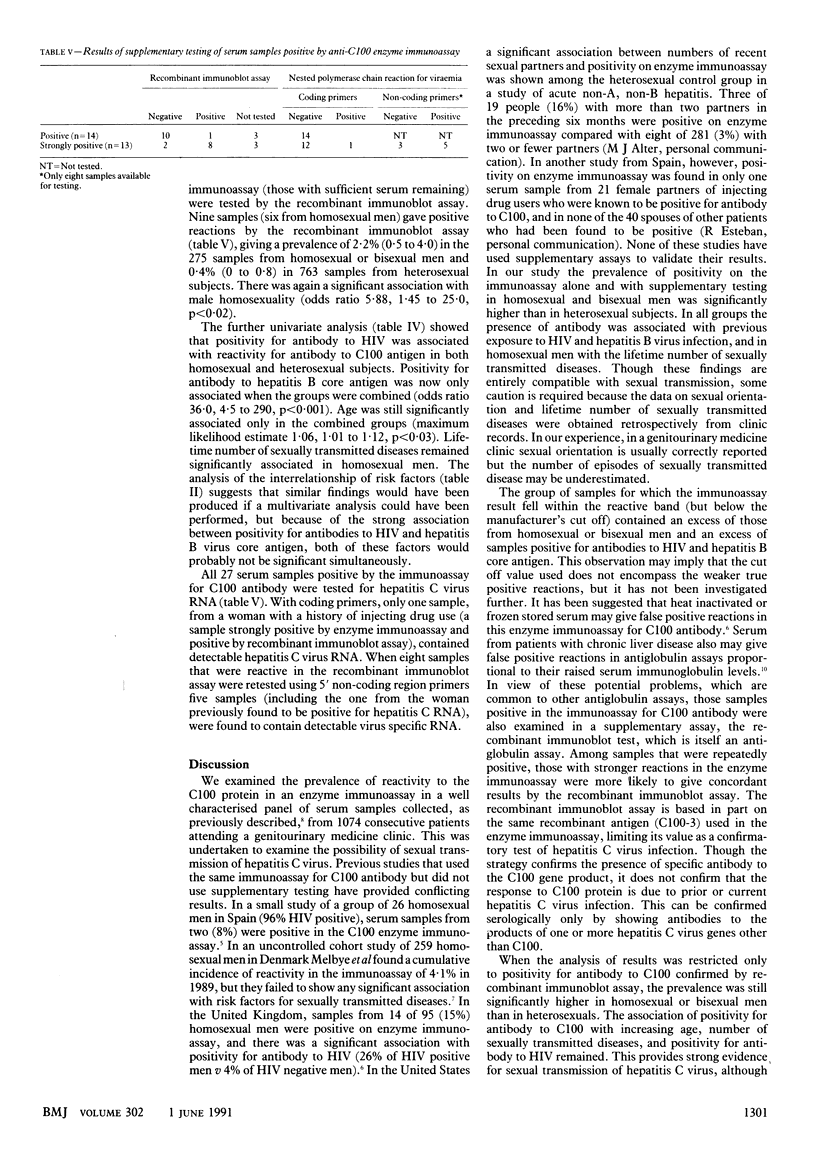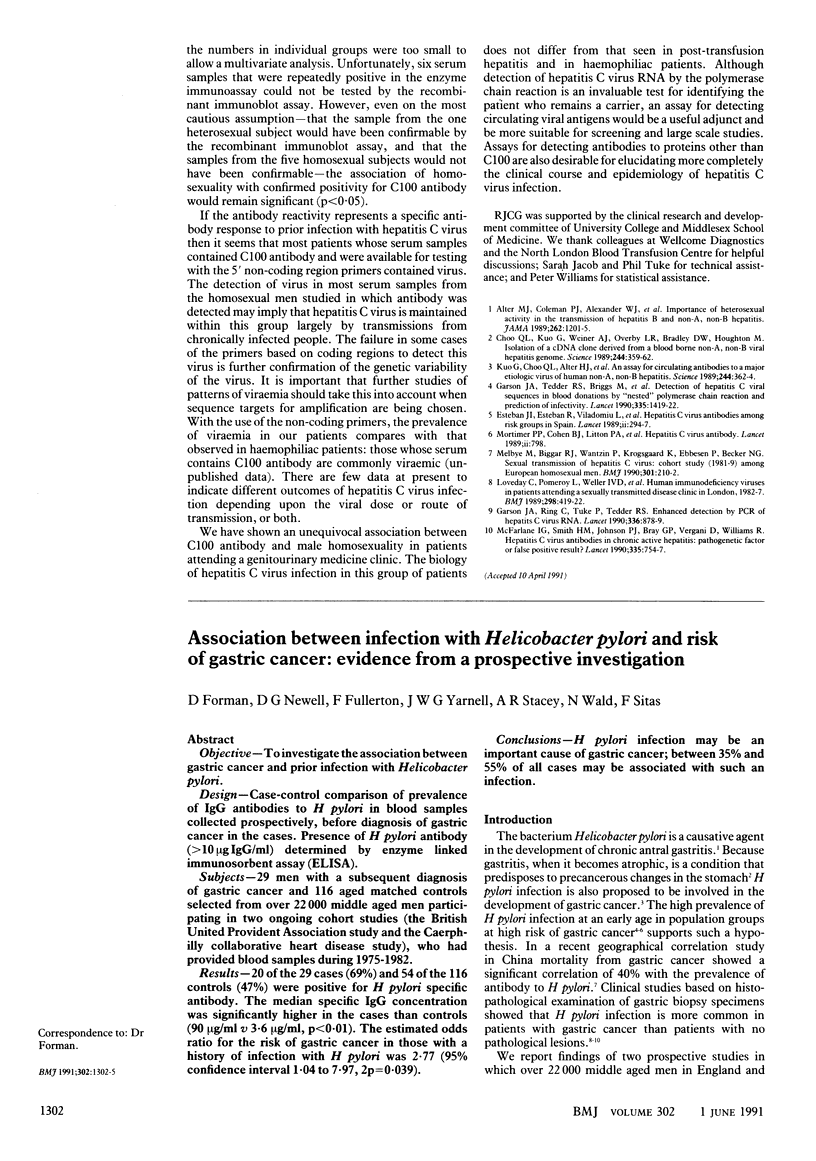Abstract
OBJECTIVE--To determined the prevalence of hepatitis C virus infection and associated risk factors in patients attending a genitourinary medicine clinic, as evidence for sexual transmission. DESIGN--Seroprevalence estimated by reactivity in an enzyme immunoassay for antibodies to C100 protein with supplementary testing with a recombinant immunoblot assay and an assay for hepatitis C virus RNA. SETTING--Outpatient genitourinary medicine clinic in central London. PATIENTS--The panel of 1046 serum samples was from 1074 consecutive patients attending the clinic during November and December 1987 and having blood taken for routine testing for syphilis. Before samples were anonymised demographic and risk factor information was extracted from the clinic notes. Samples had already been tested for antibody to HIV-I and antibody to hepatitis B core antigen. MAIN RESULTS--Significantly more homosexual subjects than heterosexual subjects were positive for hepatitis C antibody determined by enzyme immunoassay alone (19/275 (6.9%) v 8/771 (1.0%), odds ratio 7.14, p less than 0.0001) and also when reactive serum samples were also tested by recombinant immunoblot assay (6/270) (2.2%) v 3/770 (0.4%), odds ratio 5.88, p less than 0.02). There were also significant associations in patients positive for hepatitis C antibody with positivity for antibodies to HIV and to hepatitis B core antigen, lifetime number of sexually transmitted diseases (homosexual men only), and age (all groups combined). Most patients whose serum samples contained specific antibodies to hepatitis C virus were viraemic. CONCLUSIONS--The study provides strong evidence for the sexual transmission of hepatitis C virus. Assays derived from other gene products are desirable to investigate the specificity and sensitivity of the enzyme immunoassay for C100 antibody as a marker of hepatitis C virus infection.
Full text
PDF



Selected References
These references are in PubMed. This may not be the complete list of references from this article.
- Alter M. J., Coleman P. J., Alexander W. J., Kramer E., Miller J. K., Mandel E., Hadler S. C., Margolis H. S. Importance of heterosexual activity in the transmission of hepatitis B and non-A, non-B hepatitis. JAMA. 1989 Sep 1;262(9):1201–1205. [PubMed] [Google Scholar]
- Choo Q. L., Kuo G., Weiner A. J., Overby L. R., Bradley D. W., Houghton M. Isolation of a cDNA clone derived from a blood-borne non-A, non-B viral hepatitis genome. Science. 1989 Apr 21;244(4902):359–362. doi: 10.1126/science.2523562. [DOI] [PubMed] [Google Scholar]
- Esteban J. I., Esteban R., Viladomiu L., López-Talavera J. C., González A., Hernández J. M., Roget M., Vargas V., Genescà J., Buti M. Hepatitis C virus antibodies among risk groups in Spain. Lancet. 1989 Aug 5;2(8658):294–297. doi: 10.1016/s0140-6736(89)90485-6. [DOI] [PubMed] [Google Scholar]
- Garson J. A., Ring C., Tuke P., Tedder R. S. Enhanced detection by PCR of hepatitis C virus RNA. Lancet. 1990 Oct 6;336(8719):878–879. doi: 10.1016/0140-6736(90)92384-t. [DOI] [PubMed] [Google Scholar]
- Garson J. A., Tedder R. S., Briggs M., Tuke P., Glazebrook J. A., Trute A., Parker D., Barbara J. A., Contreras M., Aloysius S. Detection of hepatitis C viral sequences in blood donations by "nested" polymerase chain reaction and prediction of infectivity. Lancet. 1990 Jun 16;335(8703):1419–1422. doi: 10.1016/0140-6736(90)91446-h. [DOI] [PubMed] [Google Scholar]
- Kuo G., Choo Q. L., Alter H. J., Gitnick G. L., Redeker A. G., Purcell R. H., Miyamura T., Dienstag J. L., Alter M. J., Stevens C. E. An assay for circulating antibodies to a major etiologic virus of human non-A, non-B hepatitis. Science. 1989 Apr 21;244(4902):362–364. doi: 10.1126/science.2496467. [DOI] [PubMed] [Google Scholar]
- Loveday C., Pomeroy L., Weller I. V., Quirk J., Hawkins A., Williams H., Smith A., Williams P., Tedder R. S., Adler M. W. Human immunodeficiency viruses in patients attending a sexually transmitted disease clinic in London, 1982-7. BMJ. 1989 Feb 18;298(6671):419–422. doi: 10.1136/bmj.298.6671.419. [DOI] [PMC free article] [PubMed] [Google Scholar]
- McFarlane I. G., Smith H. M., Johnson P. J., Bray G. P., Vergani D., Williams R. Hepatitis C virus antibodies in chronic active hepatitis: pathogenetic factor or false-positive result? Lancet. 1990 Mar 31;335(8692):754–757. doi: 10.1016/0140-6736(90)90870-b. [DOI] [PubMed] [Google Scholar]
- Melbye M., Biggar R. J., Wantzin P., Krogsgaard K., Ebbesen P., Becker N. G. Sexual transmission of hepatitis C virus: cohort study (1981-9) among European homosexual men. BMJ. 1990 Jul 28;301(6745):210–212. doi: 10.1136/bmj.301.6745.210. [DOI] [PMC free article] [PubMed] [Google Scholar]
- Mortimer P. P., Cohen B. J., Litton P. A., Vandervelde E. M., Bassendine M. F., Brind A. M., Hambling M. H. Hepatitis C virus antibody. Lancet. 1989 Sep 30;2(8666):798–798. doi: 10.1016/s0140-6736(89)90854-4. [DOI] [PubMed] [Google Scholar]


